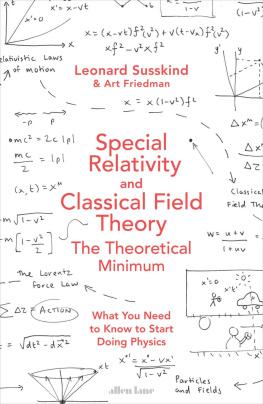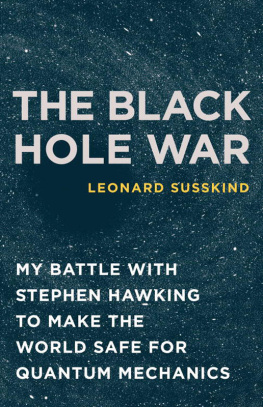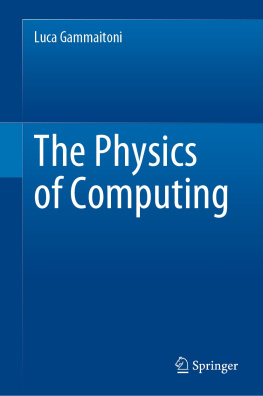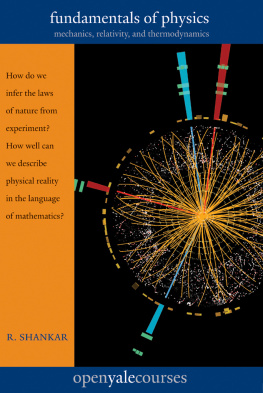THE
THEORETICAL
MINIMUM
THE
THEORETICAL
MINIMUM
_____________________________
WHAT YOU NEED to KNOW
to START DOING PHYSICS
_____________________________
LEONARD SUSSKIND
and
GEORGE HRABOVSKY
BASIC BOOKS
A Member of the Perseus Books Group
New York
Copyright 2013 by Leonard Susskind and George Hrabovsky
Published by Basic Books,
A Member of the Perseus Books Group
All rights reserved. No part of this book may be reproduced in any manner whatsoever without written permission except in the case of brief quotations embodied in critical articles and reviews. For information, address Basic Books, 250 West 57th Street, 15th Floor, New York, NY 10107-1307.
Books published by Basic Books are available at special discounts for bulk purchases in the United States by corporations, institutions, and other organizations. For more information, please contact the Special Markets Department at the Perseus Books Group, 2300 Chestnut Street, Suite 200, Philadelphia, PA 19103, or call (800) 810-4145, ext. 5000, or e-mail .
LCCN: 2012953679
ISBN 978-0-465-03174-0 (e-book)
10 9 8 7 6 5 4 3 2 1
To our spouses
those who have chosen to put up with us,
and to the students of Professor Susskinds
Continuing Education Courses
CONTENTS
Ive always enjoyed explaining physics. For me its much more than teaching: Its a way of thinking. Even when Im at my desk doing research, theres a dialog going on in my head. Figuring out the best way to explain something is almost always the best way to understand it yourself.
About ten years ago someone asked me if I would teach a course for the public. As it happens, the Stanford area has a lot of people who once wanted to study physics, but life got in the way. They had had all kinds of careers but never forgot their one-time infatuation with the laws of the universe. Now, after a career or two, they wanted to get back into it, at least at a casual level.
Unfortunately there was not much opportunity for such folks to take courses. As a rule, Stanford and other universities dont allow outsiders into classes, and, for most of these grownups, going back to school as a full-time student is not a realistic option. That bothered me. There ought to be a way for people to develop their interest by interacting with active scientists, but there didnt seem to be one.
Thats when I first found out about Stanfords Continuing Studies program. This program offers courses for people in the local nonacademic community. So I thought that it might just serve my purposes in finding someone to explain physics to, as well as their purposes, and it might also be fun to teach a course on modern physics. For one academic quarter anyhow.
It was fun. And it was very satisfying in a way that teaching undergraduate and graduate students was sometimes not. These students were there for only one reason: Not to get credit, not to get a degree, and not to be tested, but just to learn and indulge their curiosity. Also, having been around the block a few times, they were not at all afraid to ask questions, so the class had a lively vibrancy that academic classes often lack. I decided to do it again. And again.
What became clear after a couple of quarters is that the students were not completely satisfied with the laypersons courses I was teaching. They wanted more than the Scientific American experience. A lot of them had a bit of background, a bit of physics, a rusty but not dead knowledge of calculus, and some experience at solving technical problems. They were ready to try their hand at learning the real thingwith equations. The result was a sequence of courses intended to bring these students to the forefront of modern physics and cosmology.
Fortunately, someone (not I) had the bright idea to videorecord the classes. They are out on the Internet, and it seems that they are tremendously popular: Stanford is not the only place with people hungry to learn physics. From all over the world I get thousands of e-mail messages. One of the main inquiries is whether I will ever convert the lectures into books? The Theoretical Minimum is the answer.
The term theoretical minimum was not my own invention. It originated with the great Russian physicist Lev Landau. The TM in Russia meant everything a student needed to know to work under Landau himself. Landau was a very demanding man: His theoretical minimum meant just about everything he knew, which of course no one else could possibly know.
I use the term differently. For me, the theoretical minimum means just what you need to know in order to proceed to the next level. It means not fat encyclopedic textbooks that explain everything, but thin books that explain everything important. The books closely follow the Internet courses that you will find on the Web.
Welcome, then, to The Theoretical MiniumumClassical Mechanics, and good luck!
Leonard Susskind
Stanford, California, July 2012
I started to teach myself math and physics when I was eleven. That was forty years ago. A lot of things have happened since thenI am one of those individuals who got sidetracked by life. Still, I have learned a lot of math and physics. Despite the fact that people pay me to do research for them, I never pursued a degree.
For me, this book began with an e-mail. After watching the lectures that form the basis for the book, I wrote an e-mail to Leonard Susskind asking if he wanted to turn the lectures into a book. One thing led to another, and here we are.
We could not fit everything we wanted into this book, or it wouldnt be The Theoretical MinimumClassical Mechanics, it would be A-Big-Fat-Mechanics-Book. That is what the Internet is for: Taking up large quantities of bandwidth to display stuff that doesnt fit elsewhere! You can find extra material at the website www.madscitech.org/tm. This material will include answers to the problems, demonstrations, and additional material that we couldnt put in the book.
I hope you enjoy reading this book as much as we enjoyed writing it.
George Hrabovsky
Madison, Wisconsin, July 2012
Somewhere in Steinbeck country two tired men sit down at the side of the road. Lenny combs his beard with his fingers and says, Tell me about the laws of physics, George. George looks down for a moment, then peers at Lenny over the tops of his glasses. Okay, Lenny, but just the minimum.
What Is Classical Physics?
The term classical physics refers to physics before the advent of quantum mechanics. Classical physics includes Newtons equations for the motion of particles, the Maxwell-Faraday theory of electromagnetic fields, and Einsteins general theory of relativity. But it is more than just specific theories of specific phenomena; it is a set of principles and rulesan underlying logicthat governs all phenomena for which quantum uncertainty is not important. Those general rules are called classical mechanics.
The job of classical mechanics is to predict the future. The great eighteenth-century physicist Pierre-Simon Laplace laid it out in a famous quote:
We may regard the present state of the universe as the effect of its past and the cause of its future. An intellect which at a certain moment would know all forces that set nature in motion, and all positions of all items of which nature is composed, if this intellect were also vast enough to submit these data to analysis, it would embrace in a single formula the movements of the greatest bodies of the universe and those of the tiniest atom; for such an intellect nothing would be uncertain and the future just like the past would be present before its eyes








